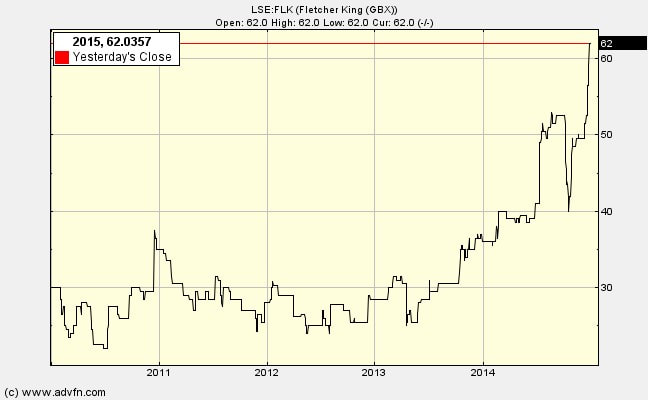|
Fletcher King (LSE:FLK) reported excellent half-year results a few days ago, including a significant boost to its net current asset value, NCAV. But I’m still not willing to pay much more for its shares than the limit set in early December. I originally bought into FK in August 2013 at a price of 30p. With the shares now at 60p (current market capitalisation is 9.2m shares x 60p = £5.5m) I have made a 110% return so far (plus a 1.5p dividend due in February). The good news
This business of providing services to commercial property owners, mostly offices, has continued to perform well, with the central London market ‘remain[ing] very strong with demand rippling out from the centre’ and ‘other major cities seeing significant yield contraction as investors seek higher returns’. Apparently all FKs departments are ‘were very active’, from its valuation department to its rent collection and fund assistance departments. Turnover was £1.828m in the half year to 31 October, which is 36% up on the same period a year ago. Profit before tax is up an even more impressive percentage, 99%, at £293,000. Apparently the directors agree with the arguments I put forward at the AGM last month because they have doubled the interim dividend to 1.5p. This is the same as the whole-year dividend in 2013/14. Dividend yield is 2.9% based only on the interim, so we should expect at least double that when the final dividend for the year is included. Some not so good news With revenue up about £486k, employee benefits expense is up £232k. Thus the workers (mostly directors) continue to take the lion-share of the value generated (other costs were up only £71k). They are not anticipating a large rise in profits in the second half: ‘Our prospects…look satisfactory although last year[’s]… results would be difficult act to follow but we will use all our efforts to do so’. To put a lot of weight on the profit numbers improving further is to move from an investment type of decision to a greater element of speculation. We simply don’t know. Now let’s look at something we do know. The balance sheet £’000s Receivables 1,394 Cash 2,338 Payables -410 Tax -185 Other creditors -370 NCAV 2767 Plus ‘available for sale investments’ 875 Extended NCAV 3642 Less 20% of receivables, to be conservative -279 Conservative NCAV 3363 Per share 36.6p Note that the company continues to meet the qualitative criteria for a NCAV investment (see earlier Newsletter postings or The Financial Times Guide to Value Investing). To stay within the boundaries of investment, i.e. with a large margin of safety and without placing ‘value on hope’ that the operations will be increasingly profitable I’ll set a price limit of 36.6p. This is 39% below the current market price. I’ll be patient. What about the shares bought previously? I continue to hold the shares I’ve already picked up, because even at 60p they are within the range of being reasonable value, even if they are no longer bargain value. Also, it is important to have a rule on not selling after a run-up in order to avoid temporary psychological influences causing a failure to hold onto multi-baggers. A rule is also important to avoid losses through frequent transaction costs – money going to the ‘croupiers’ of the share-picking game in bid-offer spreads and fees, and money going to the tax authorities. I’ll sit it out until at least August 2016, unless something interesting happens before then (e.g. I feel that the share is well ahead of itself at a time when the commercial property market is headed for trouble, or there is a takeover bid).
0 Comments
Leave a Reply. |
Archive
I wrote newsletters for almost 10 years (2014 - 23) for publication on ADVFN. Here you can find old newsletters in full. I discussed investment decisions, basics of value investing and the strategies of legendary investors. Archives
October 2020
Categories |

 RSS Feed
RSS Feed